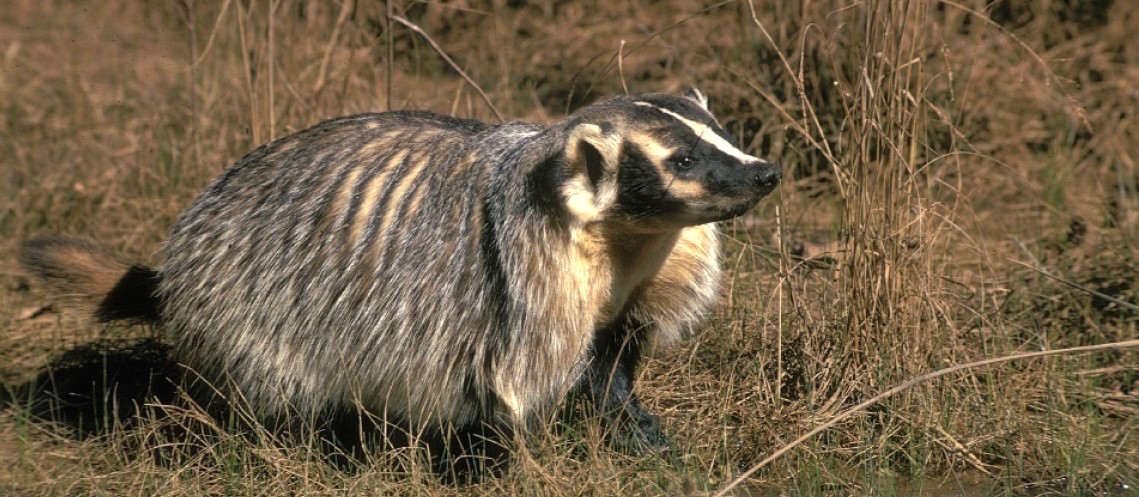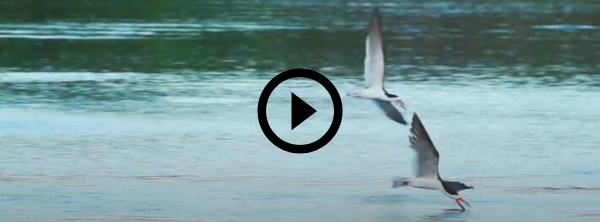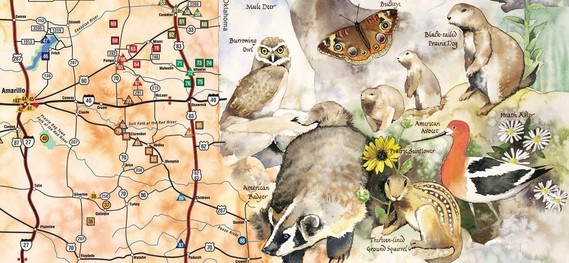
Found in West and South Texas, American badgers are fierce members of the weasel family. Unaffected by rattlesnake bites unless bit on the nose, badgers eat diamondbacks (video) for lunch. But this is no one-trick weasel, the badger also has team skills – it will pair up with a coyote to hunt. These hunting buddies were first noted by Native Americans, and a recent video shows they're still hanging out together.
We haven't seen photos or video of a badger-coyote team in Texas, but both species live here. So be on the lookout for this dynamic duo, and if you can safely get a photo, post it on iNaturalist, Facebook or Instagram, and tag us so we see it. Always keep a safe distance between yourself and wildlife.
Read about more badger superpowers (yes, they have more!) in the Texas Parks & Wildlife magazine story, Badger Swagger.

Black skimmers are coastal birds that fish by skimming the water's surface with the lower half of their bill immersed. When they spot a small fish, they nab it without missing a beat. But these graceful birds are in a steep population decline – down 70% since 1973 due to habitat loss and human disturbance, such as people getting too close to their nesting areas.
Black skimmers are colonial waterbirds – birds that nest together in large groups. If their nesting site is approached by humans, the adults frequently fly off, leaving eggs and chicks exposed to predators.
A variety of colonial waterbirds, including spoonbills, egrets and herons, nest along the coast and near inland waters. And like the black skimmer, many are experiencing steep population declines. So if you fish, boat, take photos, go birding or take walks near water, especially on the coast, watch for and avoid nesting sites from February to August. Give the birds some space so future generations of Texans can enjoy them. Read more about black skimmers in the magazine story, Surface Gliders.
4 Ways to Help Your Trees Survive Summer

Trees are like little cities, supporting chains of wildlife both above and below the ground. Maintaining tree health in summer is important since destructive insects can overwhelm a heat-stressed tree. Here are 4 tips to help trees stay healthy:
- A deep watering during the middle and end of summer is the most effective way to reduce heat stress. The Tree Care Guide (PDF) has watering tips.
- Apply mulch over the root system to keep out heat and keep in moisture.
- Limit pruning to dead limbs that pose a safety hazard.
- Avoid using weed killer or fertilizer, they can damage trees.
For the best chance at long-term success, grow trees native to your region. They have evolved to withstand the extremes of Texas summers.
Trees under 3 years old have special needs – watch the short video How to Care for Your Tree for tips on how to help them thrive.
|
Take a Drive on the Wild Side

If you're planning a driving vacation this summer, make it a wildlife-themed Texas state-cation! Great Texas Wildlife Trails maps are the perfect tool to help you plan a trip – be it for a day, a weekend or all summer long.
Each of the the 9 interactive maps has a list of area wildlife, designated driving loops, and directions to nature preserves and other sites. The Great Texas Coastal Birding Trail is comprised of the 3 coastal regions. Due to health-related safety measures, some sites may have shorter hours or be closed, so call first.
You can also buy these beautifully illustrated maps by mail. Order yours today and plan your drive on the wild side!
|